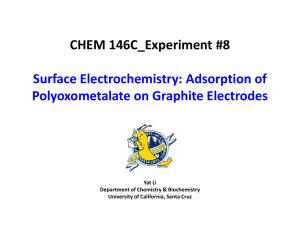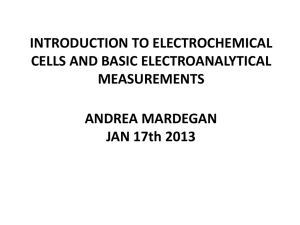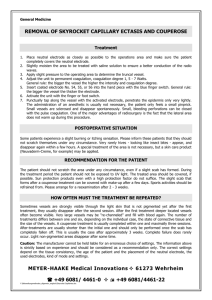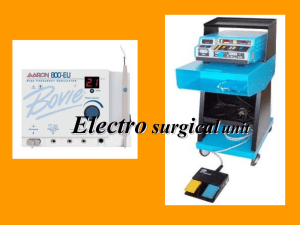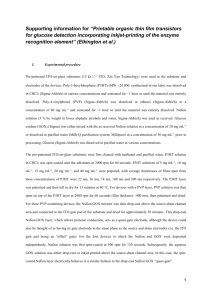STATYBA
advertisement
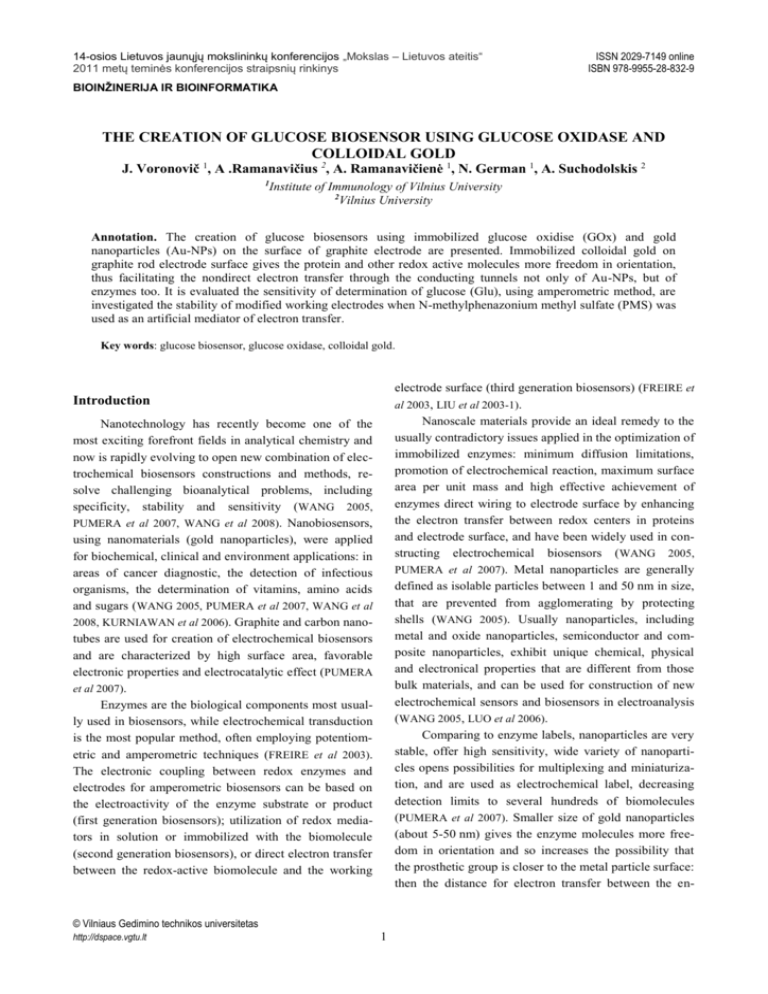
14-osios Lietuvos jaunųjų mokslininkų konferencijos „Mokslas – Lietuvos ateitis“ 2011 metų teminės konferencijos straipsnių rinkinys ISSN 2029-7149 online ISBN 978-9955-28-832-9 BIOINŽINERIJA IR BIOINFORMATIKA THE CREATION OF GLUCOSE BIOSENSOR USING GLUCOSE OXIDASE AND COLLOIDAL GOLD J. Voronovič 1, A .Ramanavičius 2, A. Ramanavičienė 1, N. German 1, A. Suchodolskis 2 1 Institute of Immunology of Vilnius University 2 Vilnius University Annotation. The creation of glucose biosensors using immobilized glucose oxidise (GOx) and gold nanoparticles (Au-NPs) on the surface of graphite electrode are presented. Immobilized colloidal gold on graphite rod electrode surface gives the protein and other redox active molecules more freedom in orientation, thus facilitating the nondirect electron transfer through the conducting tunnels not only of Au-NPs, but of enzymes too. It is evaluated the sensitivity of determination of glucose (Glu), using amperometric method, are investigated the stability of modified working electrodes when N-methylphenazonium methyl sulfate (PMS) was used as an artificial mediator of electron transfer. Key words: glucose biosensor, glucose oxidase, colloidal gold. electrode surface (third generation biosensors) (FREIRE et al 2003, LIU et al 2003-1). Nanoscale materials provide an ideal remedy to the usually contradictory issues applied in the optimization of immobilized enzymes: minimum diffusion limitations, promotion of electrochemical reaction, maximum surface area per unit mass and high effective achievement of enzymes direct wiring to electrode surface by enhancing the electron transfer between redox centers in proteins and electrode surface, and have been widely used in constructing electrochemical biosensors (WANG 2005, PUMERA et al 2007). Metal nanoparticles are generally defined as isolable particles between 1 and 50 nm in size, that are prevented from agglomerating by protecting shells (WANG 2005). Usually nanoparticles, including metal and oxide nanoparticles, semiconductor and composite nanoparticles, exhibit unique chemical, physical and electronical properties that are different from those bulk materials, and can be used for construction of new electrochemical sensors and biosensors in electroanalysis (WANG 2005, LUO et al 2006). Comparing to enzyme labels, nanoparticles are very stable, offer high sensitivity, wide variety of nanoparticles opens possibilities for multiplexing and miniaturization, and are used as electrochemical label, decreasing detection limits to several hundreds of biomolecules (PUMERA et al 2007). Smaller size of gold nanoparticles (about 5-50 nm) gives the enzyme molecules more freedom in orientation and so increases the possibility that the prosthetic group is closer to the metal particle surface: then the distance for electron transfer between the en- Introduction Nanotechnology has recently become one of the most exciting forefront fields in analytical chemistry and now is rapidly evolving to open new combination of electrochemical biosensors constructions and methods, resolve challenging bioanalytical problems, including specificity, stability and sensitivity (WANG 2005, PUMERA et al 2007, WANG et al 2008). Nanobiosensors, using nanomaterials (gold nanoparticles), were applied for biochemical, clinical and environment applications: in areas of cancer diagnostic, the detection of infectious organisms, the determination of vitamins, amino acids and sugars (WANG 2005, PUMERA et al 2007, WANG et al 2008, KURNIAWAN et al 2006). Graphite and carbon nanotubes are used for creation of electrochemical biosensors and are characterized by high surface area, favorable electronic properties and electrocatalytic effect (PUMERA et al 2007). Enzymes are the biological components most usually used in biosensors, while electrochemical transduction is the most popular method, often employing potentiometric and amperometric techniques (FREIRE et al 2003). The electronic coupling between redox enzymes and electrodes for amperometric biosensors can be based on the electroactivity of the enzyme substrate or product (first generation biosensors); utilization of redox mediators in solution or immobilized with the biomolecule (second generation biosensors), or direct electron transfer between the redox-active biomolecule and the working © Vilniaus Gedimino technikos universitetas http://dspace.vgtu.lt 1 zyme and electrode will be shorter and transfer of electron easer (LIU et al 2003-2). Modified by gold nanoparticles electrode can be prepared by binding gold nanoparticles with functional groups of covalent self-assembled monolayers, by direct deposition of nanoparticles onto the bulk electrode surface or by incorporating colloidal gold into the electrode. The better immobilizing of glucose oxidase or gold nanoparticles could be achieved by cross-linking with bifunctional agents such as glutaraldehyde or by mixing with components of composite electrodes (YÁÑEZ-SEDEÑO et al 2005). The aim of present work was to create GOx and AuNPs based biosensors and to use in the determination of glucose. ware in amperometry modes. A conventional threeelectrodes system comprising a prepared working graphite electrode (modified as was described above), platinum as an auxiliary electrode and silver/silver chloride with 3 mol l-1 KCl as a reference was employed for all electrochemical experiments. All experiments were performed at room temperature in stirred sodium acetate or sodium phosphate buffer solutions with KCl. Electrochemical detection of the analytical signal was performed in the absent and presence of PMS and different concentration of glucose. Special conditions in stability test: between measurements, the GOx-electrode and Au-NPs/GOx- or GOx/Au-NPs-electrodes were stored at 4°C in a closed vessel hanging over buffer solution. Results Materials and methods In the work were created two types of the amperometric biosensors for a determination of Glu. One of them was based on electron transfer between a graphite electrode and immobilized GOx, which can catalyze the oxidation of analyte; other – between a graphite electrode, GOx and Au-NPs. Good established and commercially available the GOx-based biosensor is the primary model system in the development of new sensing materials and methods. In first type of biosensor GOx was deposited on the graphite electrode and in the presence of Glu and dissolved oxygen GOx started to generate hydrogen peroxide and gluconolactone, which was hydrolyzing to gluconic acid (Fig. 1 (A)). The activity of enzyme was estimated during measurements by measuring the oxidation current of H2O2 produced by the enzymatic reaction. Coupled enzymatic reactions used in the Au-NPs-based enzyme electrodes with immobilized GOx and deposited directly onto the surface of graphite electrode Au-NPs are presented in Fig. 1 (B). Chemicals. Analytical grade chemicals and triply distilled water were used to prepare the solutions. It were used glucose oxidase, N-methylphenazonium methyl sulfate, D-(+)-glucose, tetrachloroauric acid, tannic acid, sodium citrate, hydrochloric acid, sodium carbonate, glutaraldehyde solution, solutions of sodium acetate and sodium phosphate buffers with KCl. Pre-treatment of working electrode. Graphite rod electrodes were sealed into epoxy to prevent contact of the electrode side surface with the solution. The working surface area of the graphite electrodes was 0.071 cm2. Graphite electrodes were modified with GOx absent (GOx-electrode) and present gold nanoparticles (GOx/Au-NPs-electrode and AuND/GOx-electrode, respectively). The synthesis of Au-NPs was described in details previously in the article. Working electrode modification by glucose oxidase and gold nanoparticles. During preparation of GOx-electrode, GOx solution was deposited on the electrode and water was evaporated at room temperature by intensive ventilation. For the preparation of Au-NP/GOx-electrode additionally gold nanoparticles colloid solution was deposited on the GOx-electrode. For the preparation of GOx/Au-NPs-electrodes gold nanoparticles colloid solution was deposited on the working electrode and after evaporation of water additionally solution of GOx was deposited. After water evaporation all electrodes were stored over 25 % solution of glutaraldehyde at room temperature in a closed vessel. Electrochemical measurements. All electrochemical measurements were performed using a computerized potentiostat Autolab/PGSTAT 30 with GPES 4.9 soft- Fig. 1. Electrocatalytic oxidation of Glu in the presence of GOx (A) or GOx and Au-NPs (B) with mediator – PMS. 2 It was seen what GOx converts glucose and O2 to gluconolactone and H2O2, but the electron transfer could follow by 2 ways: through enzyme and trough Au-NPs. In such biosensors (Fig. 1(B)) redox center of GOx is covalently plugging to electrode surface via Au-NPs, constructing stable structure of the sensor (PUMERA et al 2007). The basic advantage of perfect option for biomolecular immobilization is effectively increase of the stability and the maintenance of activity, that can be explained because the nanoparticles are chemically more active than the materials of electrode and are characterized by high surface energy. Using immobilized by GOx and modified by AuNPs graphite rod electrodes was observed hyperbolic dependence of amperometric signal on substrate (Glu) concentration from 0.1 till 100 mmol l-1 (Fig. 2). The second step of research investigation was the storage stability of GOx- and GOx/Au-NPs-electrodes towards the catalytic oxidation of Glu has been examined as well and it was evaluated the decrease in amperometric current during time cycling for Glu determination. Compare stability of both electrode types is found what storage of stability of GOx/Au-NPs-electrode decrease faster when of GOx-electrode, that could be explained by the removal of Au-NPs during cycling procedures. Conclusion GOx can be effectively immobilized on Au-NPs modified graphite electrode to produce a fast indirect electron transfer, using PMS as the mediator. Immobilized Au-NPs can facilitate electron transfer between Glu and electrode surface, then increase the enzyme loading, and have little effect on the activity of GOx. The creating electrochemical sensor displays a high sensitivity for determination of Glu and storage stability. 1 80 2 I, A 60 Acknowledgement 3 40 This work was financially supported by Lithuanian State Science and Studies Foundation project number S-6/2007 and COST program D43. 20 0 0 20 40 C(Glu) 60 80 100 Literature , mmol l-1 WANG J., Nanomaterial-based electrochemical biosensors, Analyst, 2005, 130, 421-426. PUMERA M., SÁNCHEZ S., ICHINOSE I., TANG J., Electrochemical nanobiosensors, Sensors and Actuators B, 2007, 123, 1195-1205. WANG Y., XU H., ZHANG J., LI G., Electrochemical sensors for clinic analysis, Sensors, 2008, 8, 2043-2081. KURNIAWAN F., TSAKOVA V., MIRSKY V.M., Gold nanoparticles in nonenzymatic electrochemical detection of sugars, Electroanalysis, 2006, 18, 1937-1942. FREIRE R.S., PESSOA C.A., MELLO L.D., KUBOTA L.T., Direct electron transfer: an approach for electrochemical biosensors with higher selectivity and sensitivity, J. Braz. Chem. Soc., 2003, 14, 230-243. LIU S., JU H., Reagentless glucose biosensor based on direct electron transfer of glucose oxidase immobilized on colloidal gold modified carbon paste electrode, Biosensors and bioelectronics, 2003, 19, 177-183. LUO X., MORRIN A., KILLARD A.J., SMYTH M.R., Application of nanoparticles in electrochemical sensors and biosensors, Electroanalysis, 2006, 18, 319-326. LIU S., LEECH D., JU H., Application of colloidal gold in protein immobilization, electron transfer, and biosensing, Anal. Lett., 2003, 36 1-19. Fig. 2. Calibration plot of immobilized by GOx and Au-NPs graphite rod electrode as a function of glucose concentrations. Conditions: 1, 2 and 3 curves – GOx/Au-NPs-, Au-NPs/GOx- and GOx-electrodes. Using nanomaterials in biosensors, the speed of electrochemical reaction increase (WANG 2005), and could suppose that the sensitivity of biosensors could be higher. It is seen (Fig. 2) that using Au-NPs at the surface of graphite rod electrodes the sensitivity of amperometric method increase, what could be explained by higher electron transfer from GOx to electrode. As is investigated from research results for graphite electrode based on cross-linking immobilized GOx in sodium acetate and sodium phosphate buffers the maximal speed of an enzymatic reaction are 1.8 and 1.3 times less, respectively, compare witch GOx/Au-NPs-electrode; 1.6 and 1.2 times less, compare witch Au-NPs/GOx-electrode. 3 YÁÑEZ-SEDEÑO P., PINGARRÓN J.M., Gold nanoparticlebased electrochemical biosensors, Anal. Bioanal. Chem., 2005, 382, 884-886. NEIMAN B., GRUSHKA E., LEV O., Use of gold nanoparticles to enhance capillary electrophoresis, Anal. Chem., 2001, 73, 5220-5227. GLIUKOZĖS BIOSENSORIŲ KŪRIMAS NAUDOJANT GLIUKOZĖS OKSIDAZE IR KOLOIDINĮ AUKSĄ J. Voronovič, A. Ramanavičius, A. Ramanavičienė, N. German, A. Suchodolskis Publikacijoje pateikta sukurta ir ištirta savaime besiorganizuojanti analizinė sistema, paremta fermento gliukozės oksidazės sąveika su gliukoze. Paruoštas amperometrinis analizės metodas, pritaikytas anglies elektrodo paviršiaus modifikavimu, t.y. ištirta, kad acetatiniame buferiniame tirpale didžiausiu jautrumu pasižymi anglies elektrodas, kurio sluoksnį sudaro aukso nanodalelės ir gliukozės oksidazė imobilizuotos glutaro aldehido garais. Įvertintas elektrodų elektrokatalizinių savybių kitimas laike: stabilesne laikoma GOx padengta sistema. 4
